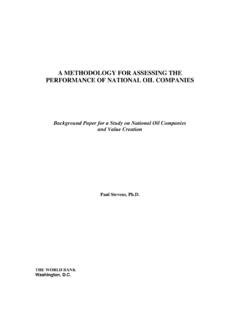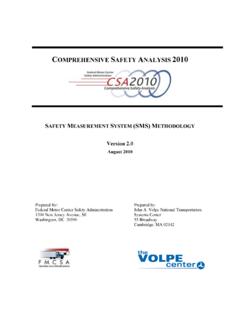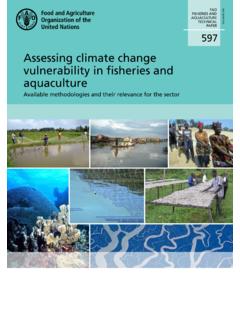Transcription of An independent review of HSE methodology for …
1 Health and Safety Executive1 of 27 pagesPrepared by the Institution of Chemical Engineers for the Interdepartmental Task Group on Societal Risk January 2006An independent review of HSE methodology for assessing societal risk Page 2 of 27 Crown copyright 2009 First published 2009 All rights reserved. No part of this publication may be reproduced, stored in a retrieval system, or transmitted in any form or by any means (electronic, mechanical, photocopying, recording or otherwise) without the prior written permission of the copyright for reproduction should be made in writing to:Licensing Division, Her Majesty s Stationery Office,St Clements House, 2-16 Colegate, Norwich NR3 1 BQor by e-mail to Page 3 of 27 Contents Executive Summary 1. Introduction 2. Approach to this review 3. Representation of Societal Risk 4. Graphical representation of Societal Risk 5. Expectation Values and Potential Loss of Life 6. Risk Aversion 7. HSE Representation of Societal Risk 8.
2 Societal Risk Tools ARICOMAH QuickFN Full Quantified Risk Analysis 9. Scenario selection 10. Multi-installation sites/Domino effects 11. Consequence Modelling 12. Source Term Modelling 13. Jet Fire 14. BLEVE 15. Flash Fire 16. Vapour Cloud Explosion 17. Dense Gas Dispersion 18. Weather Data 19. Topography 20. Vulnerability & Damage 21. Population at Risk 22. Mitigation 23. Failure Rates 24. Benchmarking 25. Transparency 26. Views of Industry 27. Findings Appendices 1. Terms of Reference 2. Team Members 3. References 4. About IChemE Page 4 of 27 Executive Summary Following a request from the Interdepartmental Task Group on Societal Risk the Institution of Chemical Engineers (IChemE) undertook a review of the application of Societal Risk Assessment to establishments subject to the Control of Major Hazard Installations Regulations 1999 (COMAH). The review team was drawn from members of the Institution together with co-opted members, and included members with both academic and industrial backgrounds; the majority with international experience and reputations in both consequence assessment and the application of risk assessment.
3 Key aspects of the Terms of Reference are given below. (see also Appendix 1) Purpose To provide an independent review of HSE s methodology for assessing societal risk (SR). To provide recommendations on how best to assess SR associated with Major Hazard Sites Terms of Reference Are the methods, models and assumptions technically sound? Is the approach used by HSE to rank Societal Risk compatible with good practice and fit for purpose ? To make recommendations on any changes to improve accuracy & robustness Although the Terms of Reference excluded consideration of criteria the team could not avoid considering the form in which the criteria were expressed. During the course of this review , discussions were held with the UK Chemical Industries Association (CIA) and the UK Petroleum Industries Association (UKPIA). Whilst there is an acceptance of societal risk in the context of COMAH by both of these industry representative bodies, they remain wary of a process that is influenced by political considerations and are concerned that HSE s report Reducing Risk Protecting People , is unconvincing in this area, almost any major event will trigger socio-political concerns.
4 In addition concerns were expressed that the approach followed in the UK should be consistent with that adopted by other countries (unfortunately the limited time available prevented a full study of this issue). IChemE s major finding is that the HSE has developed its approach to societal risk in a responsible manner that is, subject to some important concerns noted below, fit for purpose in the context of the current state of knowledge. IChemE also concludes that it is most important that the engineering profession and industry have a better understanding of HSE s approach to societal risk in order that they can work together to meet the common goal of improved safety. IChemE believes that the following will assist in this aim: In respect of the first of the Terms of Reference are the methods, models and assumptions technically sound? IChemE finds that: 1. The initial screening tool created by HSE, ARICOMAH, has serious technical limitations and is difficult to understand.
5 In recognising these limitations, HSE has developed a more sophisticated ranking tool QuickFN, which in the Institutions view should replace ARICOMAH. However, IChemE does not believe that existing ARICOMAH results should be abandoned, and they should continue to be used in deciding the priorities for carrying out QuickFN. 2. In order to improve clarity and transparency, societal risk calculations should be performed without the inclusion of any risk aversion factors and expressed graphically as the cumulative frequency of N or more fatalities occurring at frequency F called an FN Curve. Any risk aversion should be incorporated into the criteria, and displayed graphically. This will improve clarity and will also enable more direct comparisons with other countries. Page 5 of 27 The aversion debate needs to be clarified and made explicit. The HSE recognize the need for further discussion with stakeholders on criteria and the way in which risk aversion should be taken into account.
6 3. The models used by the HSE in QRA and in the calculation of societal risk are technically sound and incorporate many recent developments. In general they are considered fit for purpose , although IChemE has some concerns over long distance dispersion. In respect of the second of the Terms of Reference - Is the approach used by HSE to rank Societal Risk compatible with good practice and fit for purpose ? IChemE finds that: 4. Quantified Risk Analysis (QRA) is the most effective way to represent the societal risks associated with COMAH installations. However, a full QRA is sufficiently resource intensive to make its application disproportionate for low risk installations and the HSE accepts that such sites may not need to include QRA in their COMAH Safety Reports (this includes those sites with minimal off-site population). The HSE have developed a screening tool, QuickFN, to indicate which sites need to undertake their risk assessments in greater depth.
7 It has also been used by the HSE to indicate where existing off-site development may be a problem. These uses of QuickFN are considered to be wholly appropriate. 5. The HSE uses failure data provided by industry where this has been provided and is seen as credible. In other cases the HSE uses data from its own sources. The default data used by HSE appears to be more pessimistic than that used by other authorities such as those in the Netherlands. Industry bodies have expressed concern that such differences could result in the process industries in the UK being seriously disadvantaged. IChemE believes it is in the interests of both the HSE and industry to seek to identify failure rates which have broad support. Frequency data should be urgently reviewed to establish suitable failure rates for equipment engineered and managed to best practice . Alongside the HSE IChemE would recommend the participation of members of other engineering institutions and of industry in this study.
8 6. Although the dispersion models used by the HSE are comparable with others used in industry there remains great uncertainty about long distance dispersion effects under inversion (stable) atmospheric conditions. This together with current the inclusion of a risk aversion factor in the criteria results in the greatest weight being placed on those parts of the assessment where the uncertainties are the greatest. These technical uncertainties need to be taken into account by those setting criteria. 7. The review team noted the very wide disparity in the calculation of fatalities with different assessments of toxicity. IChemE recognises that this is a difficult area but sees it as one requiring resolution in order to improve compatibility with other European countries using QRA. 8. The calculated risks and effects of accidents should be validated against industry/world experience of accidents associated with handling hazardous materials.
9 For example the predictions of fatalities from chlorine releases appear to be high when set against over 100 years experience in handling this material. In respect of the third of the Terms of Reference - to make recommendations on any changes to improve accuracy & robustness, IChemE believes that: 9. The HSE should bring its guidance on societal risk together into one publication. In addition it should give consideration to the establishment of a process to review its QRA modelling on a regular basis. Such a review should involve both its own staff and members of professional institutions where industry has a voice. 10. The rules used in scenario selection for QuickFN should be clarified. In addition, research should be undertaken to explore methods which could identify those sites where intermediate level events (those affecting the nearby population) could lead to the overall risk being higher than estimated from Quick FN.
10 The review Team would like to thank all of those in the HSE, CIA and UKPIA who responded to the many requests for information so quickly. Without their help, IChemE would not have been able to complete its review . Page 6 of 27 1 Introduction The review team comprised members of the Institution together with co-opted members. They were drawn from both academic and industrial backgrounds and all had experience in the application of risk assessment. The team included members with international experience many of whom have published extensively on both consequence assessment and the application of risk assessment. The Terms of Reference of the study are attached in Appendix 1. Key aspects of these are Purpose a) To provide an independent review of HSE s methodology for assessing societal risk (SR). b) To provide recommendations on how best to assess SR associated with Major Hazard Sites Terms of Reference: a) Are the methods, models and assumptions technically sound b) Is the approach used by HSE to rank SR compatible with good practice and fit for purpose c) To make recommendations on any changes to improve accuracy & robustness Note: Although the Terms of Reference excluded consideration of criteria the IChemE team could not avoid considering the form in which the criteria were expressed.
















